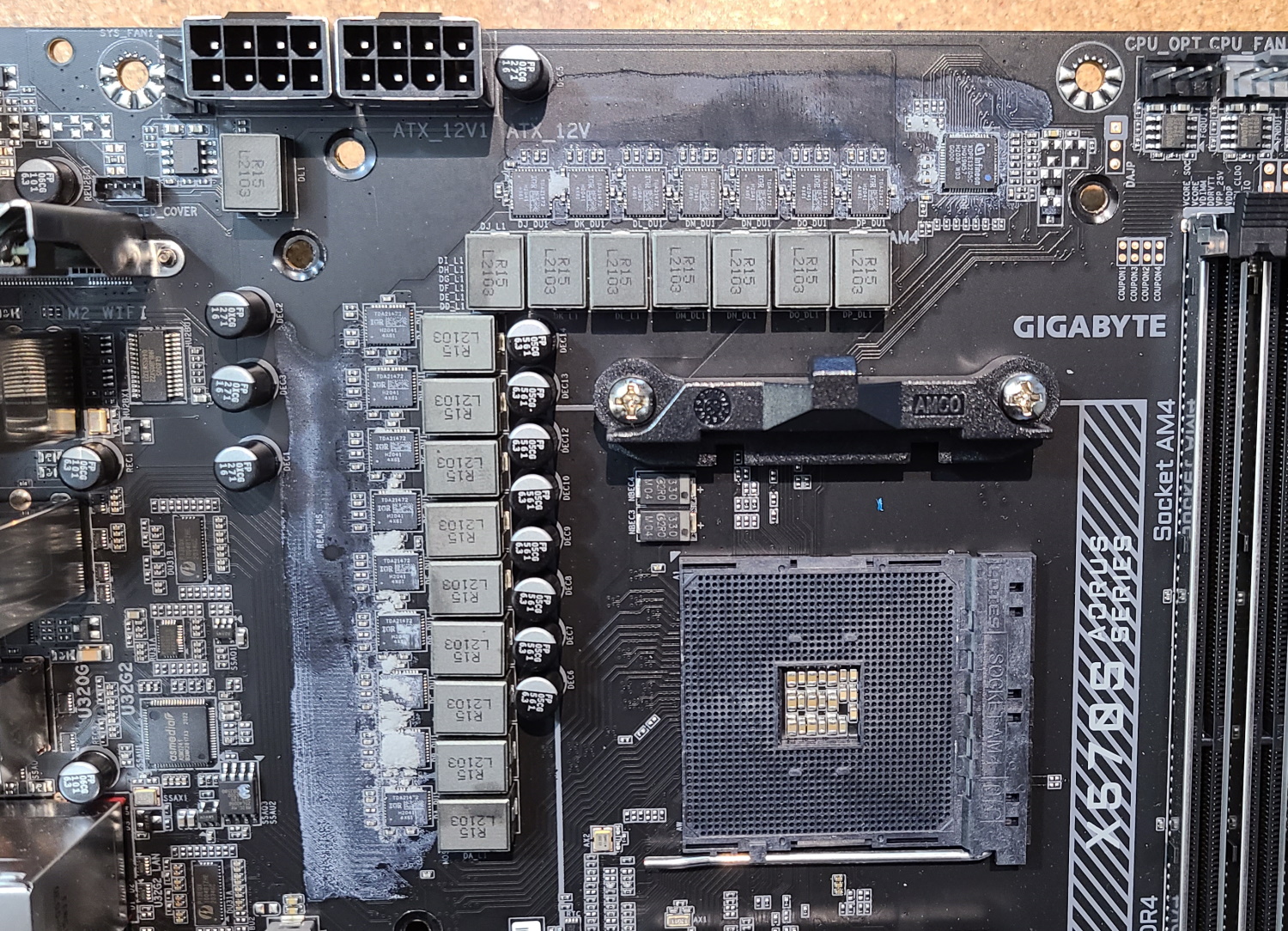Tom's Hardware Verdict
The X570S Aorus Master refresh brings Wi-Fi 6E, more capable VRMs, four M.2 sockets, plus an improved appearance. At $389.99, it isn’t the cheapest AMD-based option available but deserves serious consideration if your budget hovers around this price.
Pros
- +
+ 12 USB ports
- +
+ Fanless chipset
- +
+ Ten 4-pin Fan/pump headers
- +
+ Wi-Fi 6E included
Cons
- -
Single Ethernet port
Why you can trust Tom's Hardware
Gigabyte’s X570S Aorus Master marks the second chipset fan-omitting X570S board to make it to our test bench (the first was ASRock’s X570S Riptide). While X570S doesn’t bring with it substantive new features (outside of the absence of a fan), it does give companies the opportunity to refresh their AMD-based board lineups, add more features of their own, and make another run at our best motherboards list.
Outside of the now-fanless chipset, the X570S Aorus Master comes with improved power delivery, four M.2 sockets, an updated appearance, integrated Wi-Fi 6E, and more. At $389.99, it’s a premium mid-range offering in today’s higher-priced board landscape.
On the features front, there aren’t massive differences between the X570 and X570S versions of the Aorus Master. A slight design change yields a bit less RGB lighting and more shrouds/board coverage that, in the end, makes for a more premium appearance. Power delivery goes from 12 to 14 phases for Vcore and 50A to 70A MOSFETs, yielding more potential overclocking capability and efficiency.
Additionally, Gigabyte upgraded the Key E card from Wi-Fi 6 to Wi-Fi 6E. If you’ve got the hardware (as in one of the best gaming routers) to support the speeds, you can benefit from the latter. Otherwise, this upgrade doesn’t mean much. The X570S Master includes a USB 3.2 Gen2x2 Type-C port, along with two more USB ports (a total of 12 on the rear IO) than the X570 version. Overall, this model is certainly an improvement and it costs only $30 more than the previous X570 model.
In testing, the X570S Aorus Master did well overall, establishing itself as a capable performer among the other boards we’ve tested so far. The Master did well in AIDA Memory bandwidth tests and most of the PCMark Suite, but struggled a bit in single-threaded performance in Cinebench and Handbrake. The results weren’t notably off, but did land on the slower side of average in these tests. The board easily handled our 4.4. GHz ~1.3V overclock and our 4x8GB DDR4 3600 RAM configuration. The heatpipe-connected fin array not only looks good, but kept the VRMs running nice and cool throughout testing. Read on as we dig into more details and performance results.
Specifications - Gigabyte X570S Aorus Master
| Socket | AM4 |
| Chipset | X570S |
| Form Factor | ATX |
| Voltage Regulator | 16 Phase (14+2, 70A MOSFETs for Vcore) |
| Video Ports | ✗ |
| USB Ports | (1) USB 3.2 Gen 2x2, Type-C (20 Gbps) |
| Row 6 - Cell 0 | (5) USB 3.2 Gen 2, Type-A (10 Gbps) |
| Row 7 - Cell 0 | (4) USB 3.2 Gen 1, Type-A (5 Gbps) |
| Row 8 - Cell 0 | (4) USB 2.0 |
| Network Jacks | (1) 2.5 GbE |
| Audio Jacks | (5) Analog + SPDIF |
| Legacy Ports/Jacks | ✗ |
| Other Ports/Jack | ✗ |
| PCIe x16 | (1) v4.0 (x16) |
| Row 14 - Cell 0 | (1) v4.0 (x8) |
| Row 15 - Cell 0 | (1) v4.0 (x4) |
| PCIe x8 | ✗ |
| PCIe x4 | ✗ |
| PCIe x1 | ✗ |
| CrossFire/SLI | AMD Quad CrossfireX and CrossFireX (2-Way) |
| DIMM slots | (4) DDR4 5100+(OC), 128GB Capacity |
| M.2 slots | (2) PCIe 4.0 x4 / PCIe Only (up to 110mm) |
| Row 22 - Cell 0 | (2) PCIe 4.0 x4 / SATA + PCIe (up to 110mm) |
| U.2 Ports | ✗ |
| SATA Ports | (6) SATA3 6 Gbps (RAID 0, 1 and 10) |
| USB Headers | (1) USB v3.2 Gen 2 (Type-C) |
| Row 26 - Cell 0 | (2) USB v3.2 Gen 1 |
| Row 27 - Cell 0 | (2) USB v2.0 |
| Fan/Pump Headers | (10) 4-Pin (2A/24W each) |
| RGB Headers | (2) aRGB (3-pin) |
| Row 30 - Cell 0 | (3) RGB (4-pin) |
| Legacy Interfaces | ✗ |
| Other Interfaces | FP-Audio |
| Diagnostics Panel | 2-character debug LED |
| Internal Button/Switch | Power and Reset buttons |
| SATA Controllers | ✗ |
| Ethernet Controller(s) | Intel i225-V |
| Wi-Fi / Bluetooth | Intel AX210 (Wi-Fi 6E, 160 MHz, BT 5.2) |
| USB Controllers | ASM3242 / ASM1074 |
| HD Audio Codec | Realtek ALC1220-VB |
| DDL/DTS Connect | ✗ / DTS:X Ultra |
| Warranty | 3 Years |
The X570S Aorus Master, like all boards, includes a set of accessories designed to help get you started without an extra trip to the store. Our sample didn’t include a driver disk, so if this holds for retail, be sure to download any necessary drivers on a USB stick, so you have them when needed.
- (4) SATA cables
- RGB extension cable
- (2) Thermistors
- Wi-Fi Antenna
- Microphone
- Q-connector
- (4) M.2 screws
- User Manual/Install guide
- Aorus stickers
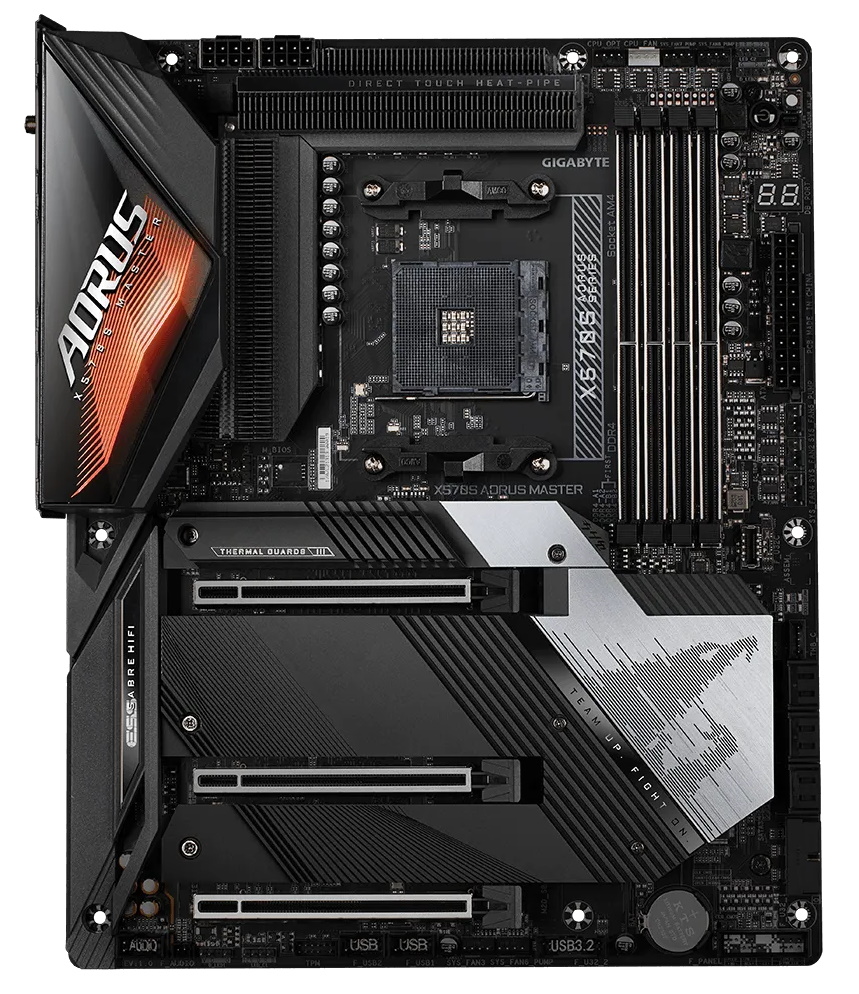
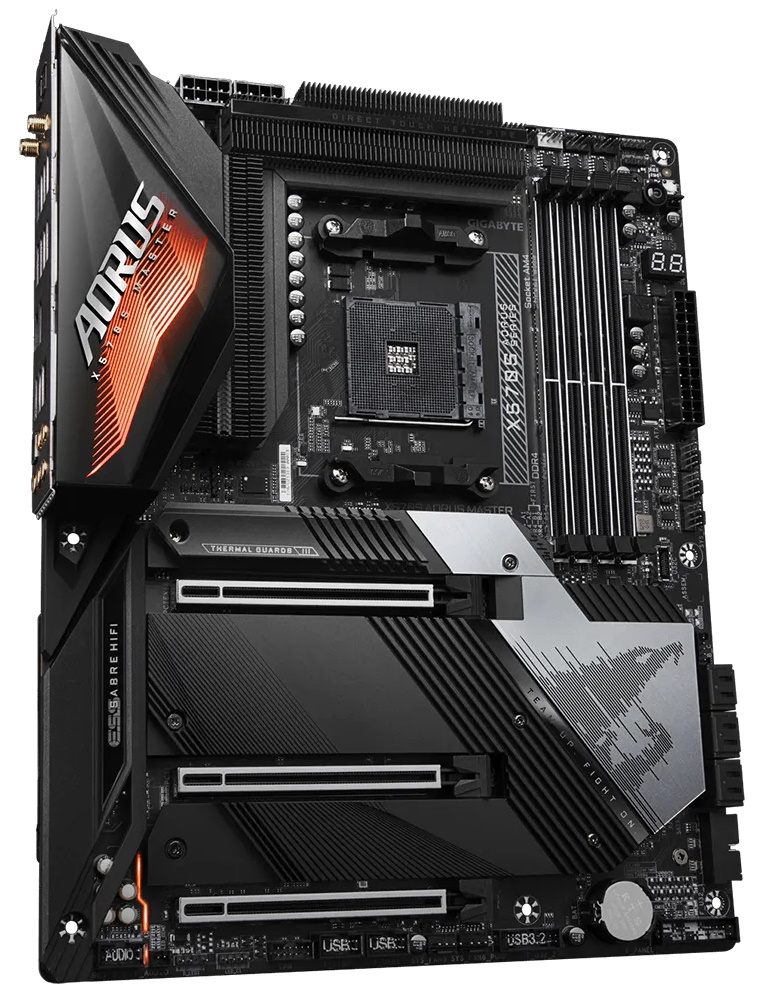
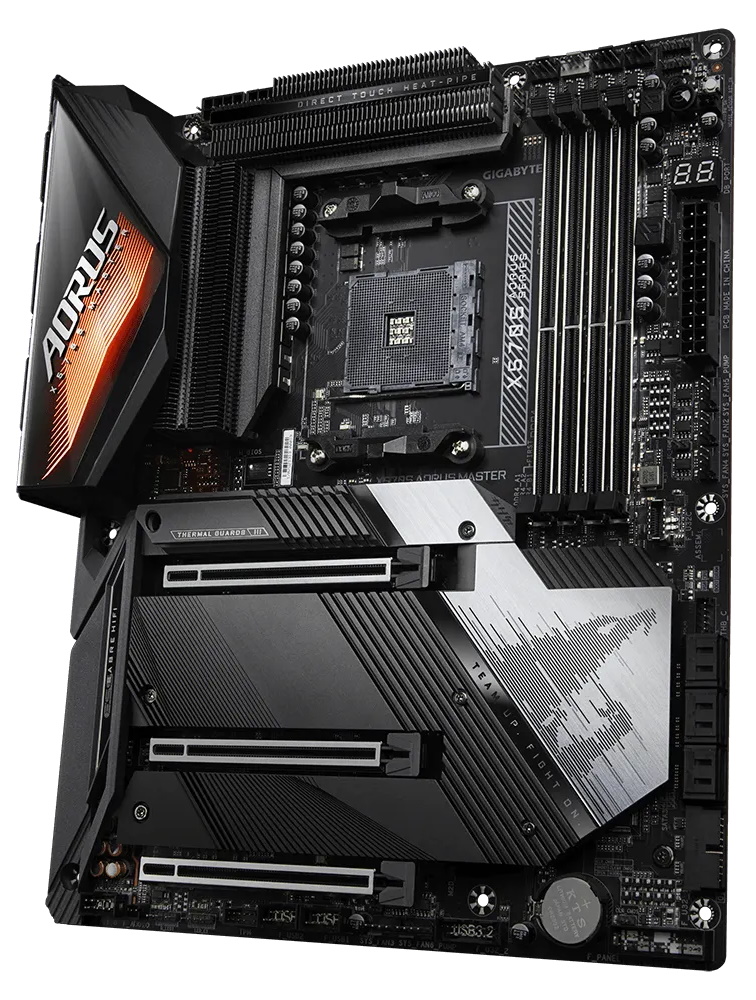
Upon unboxing and looking at the board for the first time, we’re presented with a 6-layer, matte-black PCB with some grey stenciling to the right of the socket identifying the model. The finned VRM heatsink looks good surrounding the socket and does the job well, as you’ll see later in testing. The plastic rear IO cover sports the Aorus branding and is the only area lit up by RGB LEDs. If this isn’t enough, there are headers located around the board for additional light strips.
Get Tom's Hardware's best news and in-depth reviews, straight to your inbox.
The bottom of the board is covered chiefly with shrouds and heatsinks for the M.2 sockets. There are grooves cut in for styling, which also increases surface area for cooling. Above the chipset (which has no fan!) is the Aorus flacon sitting on an aluminum accent piece. In the end, I like what the company has done to the X570S Master. It’s an improvement on the original and looks the part of a premium mid-range board.
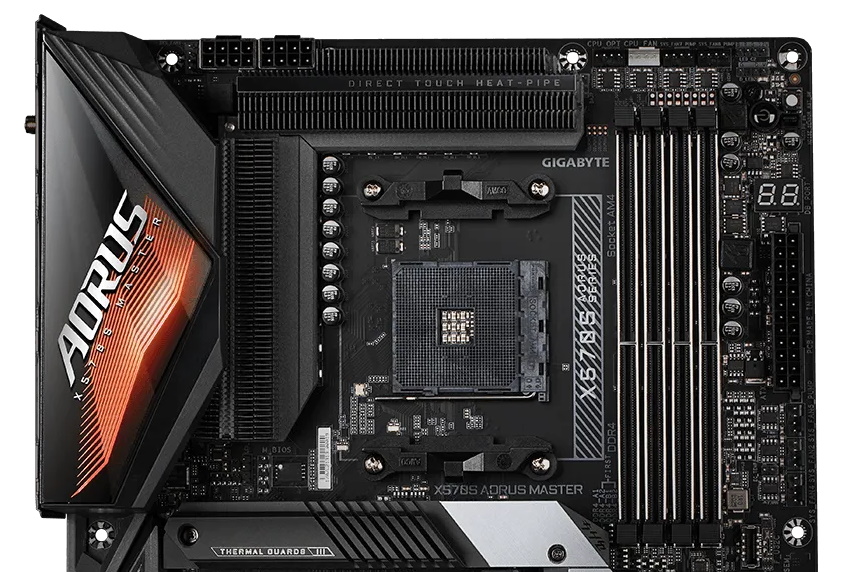
Starting with the top half of the board, we get a better look at the rear IO cover and RGB element on top. I like the trend of more tastefully implemented RGBs (which generally means fewer of them). Focusing on the socket area, we’ll start with the direct touch heatpipe for the VRMs. The finned design is unique these days and works well, keeping both VRM banks well within operating parameters. Just above this are two 8-pin EPS connectors for the CPU (one required).
To the right of the socket are four reinforced DRAM slots capable of running up to 128GB of DDR4 RAM. The specifications list memory speeds up to DDR4 5100(OC) for current-gen 5000 series processors (other processors list varying speeds per usual). As always with memory speeds, your mileage may vary. To reach these high speeds, you need a suitable processor with an excellent integrated memory controller (IMC) and the right sticks of memory to get you there. AMD’s sweet spot is still around the DDR4 3600-3733 while keeping FCLK at 1:1.
Above the DRAM slots is the first four 4-pin fan headers. All headers support both PWM and DC control, each delivering up to 2A/24W of power. This configuration should be enough to power your watercooling loop directly from the board. You can control the devices through the BIOS or the company’s Smart Fan 6 application. Just to the right of these fan headers are the first (of two each in total) RGB and ARGB headers.
Nestled between the fan headers and DRAM slots is a set of voltage read points. Here you use a multimeter to measure voltage readings directly (because software is notoriously inaccurate). The eight read points cover VCORE, Vcore_SOC, VDIMM (RAM), DDR VTT, VPP_25, VDDP, PCH-CLDO, and PCH IO. If you’re overclocking and need more accurate readings, this provides a nice value-add to the board as many at this price point don’t have user-accessible voltage read points.
On the right edge of the board are the power (large) and reset (small) buttons, the noise sensor header and a 2-character debug port. Below is the 24-pin ATX connector to power the motherboard, three more fan headers and a 2-pin temperature header. Last but not least is a front panel USB 3.2 Gen2 Type-C header.
Checking in on the VRM, the X570S features a 14-phase (12+2) setup for the Vcore and SOC, the same as the X570 version. The difference comes in the MOSFETs used. The X570S uses an Infineon XDPE132G5C PWM controller capable of running up to 16 channels. From the 8-pin EPS, power goes through the Infineon controller to 70A International Rectifier TDA1472 MOSFETs. This configuration allows up to 840A to the CPU, which is plenty for stock operation and overclocking. This is an improvement, though it’s not something that will benefit users sticking to ambient-cooled overclocks.
Jumping down to the bottom half of the board, we’ll start with the audio, located on the left side. Hidden under the shroud is the Realtek ALC1220-VB codec. This flagship-class audio includes an ESS Sabre Hi-Fi 9118 DAC for headphones along with Chemicon and WIMA audio capacitors. Also visible is the audio separation line keeping the rest of the motherboard away from the audio bits. Although the codec used is from the last generation, it’s one of the best available and performs well enough for many users.
In the middle of the board are three full-length PCIe slots and four M.2 sockets. Starting with PCIe, the top two are connected via the CPU while the bottom uses chipset lanes. For a single GPU, use the top slot, which runs at PCIe 4.0 x16 speeds (with 5000 series processors). The middle slot runs up to PCIe 4.0 x8, and when populated the top slot also drops to x8. Last, the bottom slot supports up to PCIe 4.0 x4 speeds (depending on the processor’s capabilities). If a device is installed in the M2C_SB M.2 socket, this slot is disabled. Though it is capable (by lane count) to run Nvidia SLI, only AMD Quad-GPU Crossfire and 2-Way AMD Crossfire are listed as supported.
On the M.2 side of things, the new Master has a total of four sockets. The top socket, M2A_CPU is, as you likely guessed by the name, connected to the CPU and offers up to PCIe 4.0 x4 (64 Gbps) speeds, supporting up to 110mm devices. M2B_SB, M2C_SB, and M2D_SB are chipset attached, supporting up to PCIe 4.0 x4 speeds and 110mm devices as well. Lastly, to the right of the chipset area are six SATA ports and a single USB 3.2 Gen1 front panel header. With no SATA lanes shared, you can run up to six SATA devices and four M.2 modules simultaneously.
Across the bottom are several headers, including USB ports and RGB headers. Here’s the complete list, from left to right:
- Front panel audio
- 3-pin aRGB and 4-pin RGB headers
- TPM header
- (2) USB 2.0 headers
- 2-pin temperature header
- (2) Fan headers
- Front panel USB 3.2 Gen1 header
- Clear CMOS jumper
- Front panel
In looking at the pre-installed rear IO, the thing that jumps out to me is the 12 USB ports. That configuration is more frequently (though still rare) used in more expensive motherboards. So if you need that many (although few do), this is the least-costly board with this many USB ports. There’s four USB 2.0 ports, five USB 3.2 Gen2 ports, two USB 3.2 Gen1 ports, and a USB 3.2 Gen2x2 Type-C port. On the left side are Clear CMOS and Q-Flash Plus buttons. Use the latter to flash your BIOS without a CPU. Next, we see the two Wi-Fi 6E antenna connections, the Intel 2.5 GbE port and the 5-plug plus SPDIF audio stack.
MORE: Best Motherboards
MORE: How To Choose A Motherboard
MORE: All Motherboard Content

Joe Shields is a staff writer at Tom’s Hardware. He reviews motherboards and PC components.
-
gjergjik Why the three gigabyte motherboards perform in the 80k point range in 7zip compression test, and the other boards in the 88k-91k point range?Reply
There is a big 10% percent difference. Where does it come from? -
waltc3 More informative article would be a point-by-point comparison with the x570 Aorus Master--which btw is completely silent even with the PCH fan (I don't believe I have ever heard it during the last two years of operation!) I would still choose the plain Master--but the extra NVMe port is nice--still, I like having two LAN controllers (versus 1 in the S) and I especially like the mechanically switched dual-bios in the regular Master! I won't buy a motherboard without those mechanical switches!Reply -
lee280269 Just bought the Arorus Master x570S fanless revision. It was expensive but i now finally have PCIE 4 across the board and i now get the full speeds of all my usb's / M.2's and SSD'sReply
transfer rates for example between the 4 M.2's average between 1.4gbs to 1.9gbs and even my USB type c RAID 0 box with 2 SSD's will consistently transfer 2 separate batches of files at the same time at well over 400mbs each making a usb throughput in excess of 800mbs. 270gb of stuff took just a few mins to throw across.
The only downside to all this speed and unleashed performance is the increased graphics card idle temps as ALL the 4 M.2's sit under a cooling plate directly under the graphics card slot.
